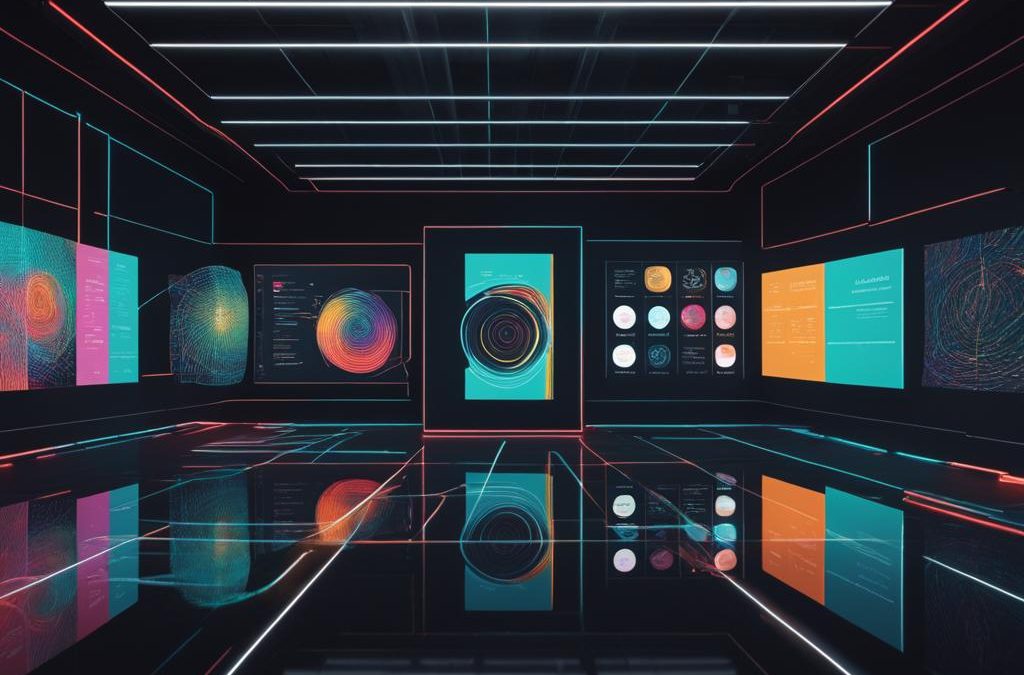In today’s digital landscape, artificial intelligence (AI) plays a crucial role in generating content across various platforms. However, ensuring the accuracy and authenticity of AI-generated content is a major concern. How well can AI models self-detect their own generated content? Let’s delve into a recent study that examined the effectiveness of AI models in the realm of content detection.
Key Takeaways:
- AI models such as Bard, ChatGPT, and Claude were tested for their ability to self-detect their own generated content.
- Bard and ChatGPT showed higher success rates in self-detection compared to Claude.
- The training data and fine-tuning process significantly influenced the AI models’ self-detection capabilities.
- Artifacts in AI-generated content, unique to each model, can be identified and used for self-detection.
- Further research is needed to compare these AI models with other content detection tools.
Artifacts in AI Generated Content
AI detectors are trained to identify artifacts in AI-generated content. These artifacts are unique to each AI model and are a result of the underlying transformer technology.
When it comes to AI content detection, understanding the presence of artifacts is crucial. These artifacts can be defined as distinct patterns or characteristics that are specific to each AI model. By analyzing and recognizing these unique artifacts, AI detectors can determine the origin of the generated content.
Artifacts in AI-generated content can manifest in various forms, such as linguistic patterns, sentence structures, or semantic inconsistencies. They can also be observed in the choice of vocabulary, the flow of ideas, or the overall style of writing.
The researchers conducting the study found that the uniqueness of training data and fine-tuning plays a significant role in the ability of AI models to self-detect their own content. AI models like Bard and ChatGPT, which undergo extensive training using diverse datasets and advanced algorithms, are more successful in identifying their own content compared to other AI models.
By leveraging advanced content detection algorithms, AI models can analyze their own generated content and identify the specific artifacts that distinguish it from content generated by other models. This self-detection capability enables AI models to develop a deeper understanding of their own strengths and limitations.
The following table summarizes the key artifacts identified in AI-generated content:
| AI Model | Unique Artifacts |
|---|---|
| Bard | Linguistic patterns, sophisticated vocabulary, coherent narrative structure |
| ChatGPT | Conversational tone, contextually relevant responses, diverse linguistic style |
| Claude | Multilingual expertise, reduced biases, emphasis on clarity and accuracy |
Methodology and Testing
To evaluate the effectiveness of AI models in self-detecting their own generated content, the researchers conducted a comprehensive and rigorous testing process. The study involved three prominent AI models: ChatGPT, Bard, and Claude. A dataset consisting of fifty different topics was used for testing.
Using the same prompts, all three AI models were tasked with generating essays for each topic. The generated content included both original essays and paraphrased versions. To facilitate self-detection, zero-shot prompting was utilized.
The researchers employed a baseline AI detection tool called ZeroGPT to compare the accuracy rates of self-detection among the AI models. This tool served as a benchmark for evaluating the performance of ChatGPT, Bard, and Claude in detecting their own content.
Evaluation Method
- AI Models Tested:
- ChatGPT
- Bard
- Claude
- Testing Process:
- Dataset: 50 different topics
- Prompts: Identical prompts given to each AI model
- Content Types: Original essays and paraphrased versions
- Zero-shot prompting used for self-detection
- Comparison with ZeroGPT as baseline AI detection tool
Through this methodology, the researchers aimed to assess the AI models’ capabilities in self-detecting their own generated content. The results of the testing process provide valuable insights into the performance of ChatGPT, Bard, and Claude in the context of AI content detection.

Research Findings
Stay tuned for Section 4 of the article to discover the intriguing results of the self-detection tests, analyzing the accuracy rates of each AI model and the differentiated performance among them.
Results: Self-Detection
The self-detection tests yielded interesting results regarding the ability of AI models to detect their own generated content. Bard and ChatGPT demonstrated success in self-detection, while Claude faced challenges in identifying its own content. Additionally, the AI detection tool ZeroGPT displayed better performance in detecting Bard and ChatGPT content compared to Claude. These findings highlight the presence of detectable artifacts generated by Bard and ChatGPT, distinguishing them from Claude.
“The ability of AI models to self-detect their own content has implications for ensuring transparency and accountability in AI-generated materials.” – Researcher
To shed light on the results, a comparative analysis table is presented below:
| AI Model | Self-Detection Success |
|---|---|
| Bard | High |
| ChatGPT | High |
| Claude | Low |
| ZeroGPT (AI detection tool) | Effective for Bard and ChatGPT content |
From the table, it is evident that Bard and ChatGPT outperform Claude in self-detection. While Bard and ChatGPT consistently identified their own generated content, Claude struggled with recognition. Furthermore, the AI detection tool ZeroGPT showcased better performance in detecting content produced by Bard and ChatGPT. These findings emphasize the detectable nature of the artifacts produced by Bard and ChatGPT, enabling their differentiation from content generated by Claude.
The findings from these self-detection tests have substantial implications for AI content detection and the development of AI models. By understanding the varying capabilities of different AI models in self-detection, researchers and developers can enhance transparency and accountability in AI-generated content.
Results: Self-Detecting Paraphrased Content
In addition to testing the self-detection of original essays, the researchers also examined how well AI models could detect their own paraphrased content. In this test, both Bard and ChatGPT demonstrated similar success rates in identifying their paraphrased content. However, it is noteworthy that ChatGPT had a slightly lower success rate compared to the original essay test. On the other hand, Claude displayed an interesting capability by successfully self-detecting the paraphrased content, despite having difficulty detecting the original essays.
This finding suggests that the unique inner workings of each transformer model may contribute to their self-detection capabilities. While Bard and ChatGPT may possess inherent similarities that enable them to identify paraphrased content, the specifics of their respective models may result in differences in efficiency. Claude’s performance in this aspect indicates that it may employ alternate mechanisms to identify rephrased content, despite struggling with original essays.

Placing the image of AI content detection here adds visual relevance to the topic. It represents the cutting-edge technology involved in self-detecting paraphrased content, underscoring the significance of this research.
Results: AI Models Detecting Each Other’s Content
In the test of how well each AI model detected content generated by the other models, Bard was the easiest to detect for the other AI models. ChatGPT and Claude struggled to detect each other’s generated content. This highlights the potential of self-detection as a promising area of study. The results of this specific test do not claim to be conclusive about AI detection in general, but they suggest that AI models perform better at self-detection compared to other AI content detection tools.
AI content detection is a crucial area of research, and these findings shed light on the capabilities and limitations of different AI models. While Bard demonstrated higher detectability among AI models, ChatGPT and Claude faced challenges in detecting each other’s content. Understanding these nuances is essential for improving AI content detection mechanisms and developing more robust solutions for combating AI-generated misinformation and deepfakes.
Researchers discovered that AI models display variations in their ability to self-detect their own generated content, with Bard showcasing the highest detectability among the tested models.
Self-detection by AI models has significant implications for ensuring the integrity and authenticity of machine-generated content. By enhancing AI models’ self-detection capabilities, we can strengthen content moderation, plagiarism detection, and improve overall transparency in the era of AI-powered content creation.
| AI Models | Self-Detection |
|---|---|
| Bard | Easiest to detect among AI models |
| ChatGPT | Struggled to detect content from other models |
| Claude | Struggled to detect content from other models |
As AI technology progresses, further research and development are needed to enhance AI content detection algorithms. By continuously refining the self-detection capabilities of AI models, we can greatly strengthen overall content quality control, combat the spread of misinformation, and foster trust in AI-generated content.
Conclusion
AI content detection is a complex task, and the results of the study confirm that AI models have varying success rates in self-detecting their own generated content. Bard, ChatGPT, and Claude each have strengths and weaknesses in self-detection and detecting each other’s content. Further research is needed to compare these AI models to other state-of-the-art content detection tools. As the field of AI continues to evolve, responsible development practices and transparency around limitations are crucial to building trust in AI systems.
AI image detection and AI video detection are also important areas of study, where AI models are being trained to analyze images and videos for a variety of applications. AI algorithms are designed to recognize objects, scenes, and patterns within visual content, enabling automated content analysis and understanding.
Key Takeaways:
- AI content detection is a complex task, with varying success rates among AI models.
- Responsible development practices and transparency are crucial for building trust in AI systems.
- Further research is needed to compare AI models to other content detection tools.
- AI image detection and AI video detection play important roles in automated content analysis.
Recommendations:
Based on the findings of the study, it is recommended that AI developers and researchers focus on improving the self-detection capabilities of AI models. Enhancing the accuracy and reliability of AI content detection is essential for addressing issues such as misinformation, deepfakes, and biased content. Additionally, ongoing research and development in AI image detection and AI video detection should continue to expand the capabilities of AI systems in analyzing visual content.
To ensure the responsible use of AI, it is important to establish ethical guidelines and regulations for content detection AI. This includes ensuring transparency in AI systems, providing explanations for AI-generated content, and allowing users to verify the authenticity of AI-generated content. By implementing these measures, we can harness the power of AI while mitigating its potential risks.
To conclude, AI content detection, AI image detection, and AI video detection are transformative technologies that have the potential to revolutionize various industries. As AI continues to advance, it is crucial to prioritize the responsible development and use of AI systems to build a safer and more trustworthy digital ecosystem.
Key Differences Among AI Chatbots
When it comes to AI chatbots, namely ChatGPT, Claude, and Bard, each one has its own unique strengths, weaknesses, and areas of expertise. ChatGPT excels in engaging in human-like conversations and producing creative written content. It’s the go-to choice for natural language processing and generating conversational responses.
Claude, on the other hand, focuses on reducing biases and possesses strong multilingual capabilities. This AI chatbot is designed to provide inclusive and diverse interactions, making it ideal for businesses with a global customer base.
Bard, a powerful AI chatbot, stands out for its ability to integrate with real-time data sources through web integration. This feature enables it to access and provide up-to-date information, making it particularly useful for applications requiring real-time data analysis.
It is crucial for businesses to thoroughly understand the capabilities and limitations of each AI chatbot before integrating them into their operations. This understanding will allow businesses to leverage the specific strengths of each chatbot, whether it’s for human-like conversations, bias reduction, multilingual support, or real-time data analysis. By making informed decisions, businesses can maximize the potential of AI chatbots and enhance their overall customer experience.
FAQ
What is AI content detection?
AI content detection refers to the use of artificial intelligence algorithms and models to identify and analyze content, such as text, images, and videos, for various purposes, including identifying artifacts, detecting biases, monitoring for inappropriate or harmful content, and improving content quality.
How effective are AI models in self-detecting their own generated content?
The effectiveness of AI models in self-detecting their own generated content varies. In the study, researchers found that AI models like ChatGPT and Bard had higher success rates in self-detection compared to Claude. The uniqueness of the training data and fine-tuning contribute to the AI models’ ability to self-detect their own content.
What are artifacts in AI-generated content?
Artifacts are unique characteristics or patterns present in AI-generated content that are specific to each AI model. These artifacts are a result of the underlying transformer technology used in the AI models’ training and generation processes. AI detectors are trained to identify and analyze these artifacts to determine the origin of the content.
How were the AI models tested for self-detection?
The researchers conducted tests using a dataset of fifty different topics. Each AI model, including ChatGPT, Bard, and Claude, was given the same prompts to generate essays for each topic, both original and paraphrased. Zero-shot prompting was used to self-detect the AI-generated content. The accuracy rates of self-detection were then analyzed and compared.
Which AI models performed better at self-detection?
In the study, Bard and ChatGPT performed better at self-detecting their own generated content compared to Claude. The results showed that Bard and ChatGPT were more successful in detecting their own content, while Claude had difficulty detecting its own content. ZeroGPT, an AI detection tool, performed better at detecting Bard and ChatGPT content compared to Claude.
Did the AI models perform better at self-detecting original content or paraphrased content?
The AI models, Bard and ChatGPT, had similar success rates in detecting their own paraphrased content compared to the original essays. However, ChatGPT had a lower success rate in self-detecting its paraphrased content compared to the original essays. Interestingly, Claude was able to self-detect the paraphrased content, even though it had difficulty detecting the original essays.
How well did the AI models detect each other’s generated content?
In the test of detecting content generated by other AI models, Bard was the easiest to detect for the other AI models. ChatGPT and Claude struggled to detect each other’s generated content. This suggests that self-detection among AI models is a promising area of study and that AI models perform better at self-detection compared to other AI content detection tools.
What are the key takeaways from the study on AI content detection?
The study confirmed that AI models, such as Bard, ChatGPT, and Claude, have varying success rates in self-detecting their own generated content. The uniqueness of training data and fine-tuning contribute to the AI models’ ability to self-detect. Further research is needed to compare these AI models to other state-of-the-art content detection tools to better understand their capabilities and limitations.
What are the key differences among AI chatbots like ChatGPT, Claude, and Bard?
Each AI chatbot, including ChatGPT, Claude, and Bard, has its own unique strengths, weaknesses, and usage scenarios. ChatGPT excels in human-like conversations and creative writing. Claude focuses on reducing biases and multilingual abilities. Bard stands out for its access to real-time data through web integration. Understanding the capabilities and limitations of each AI chatbot is important for businesses when integrating AI into their operations.








